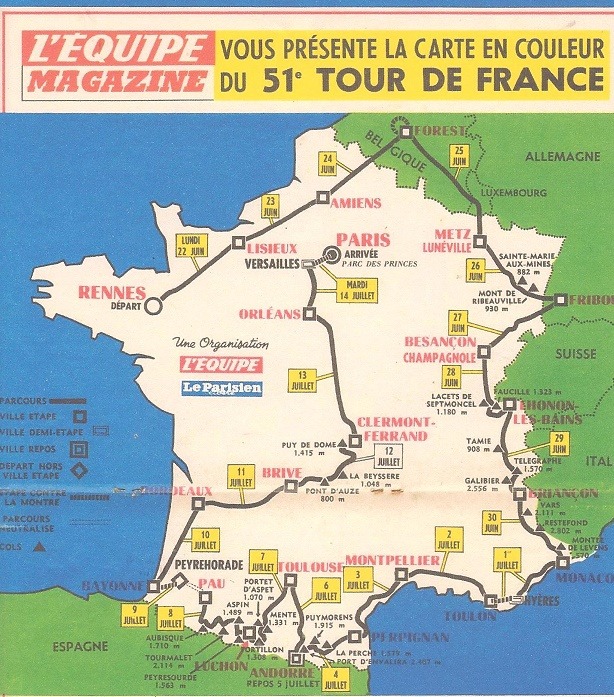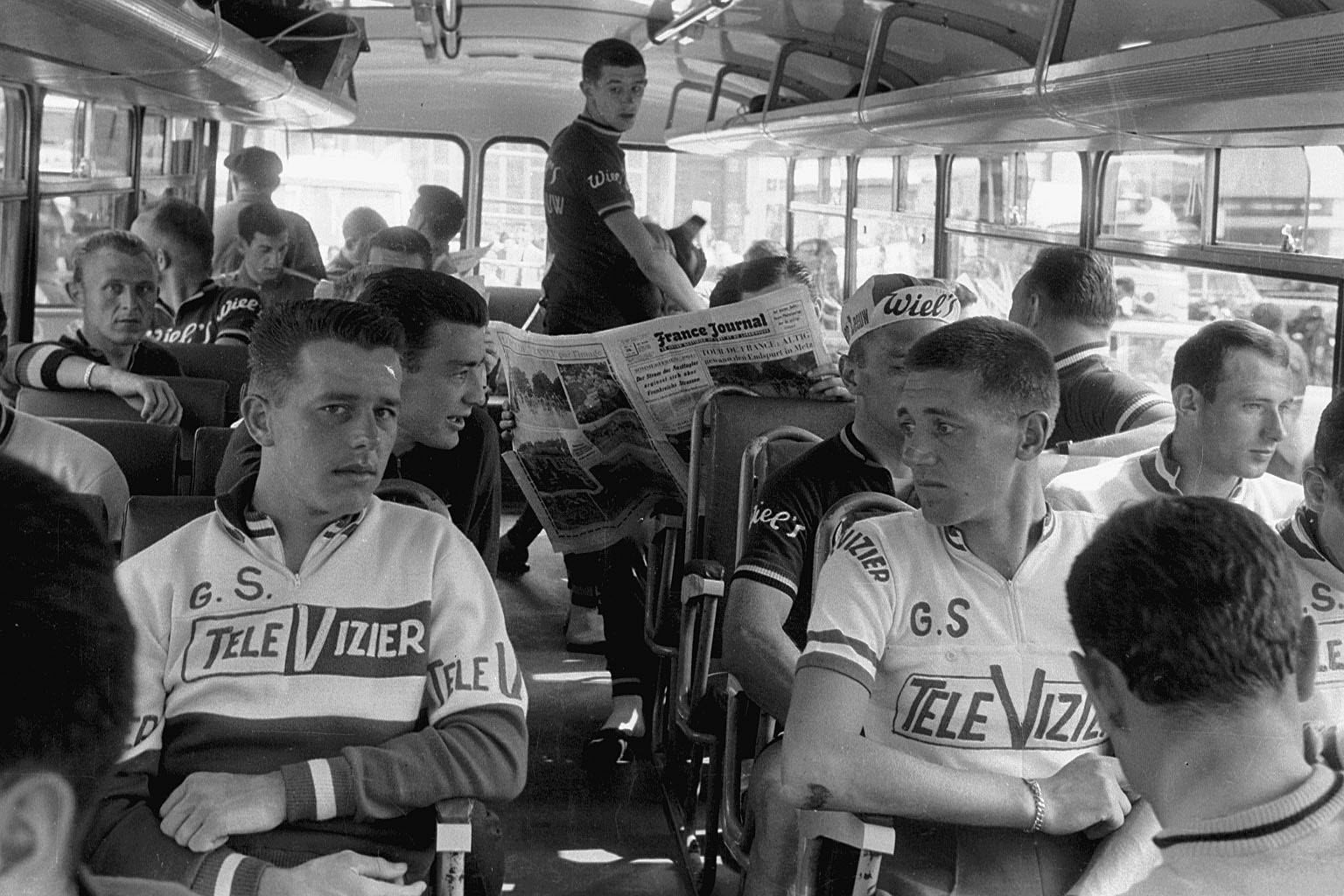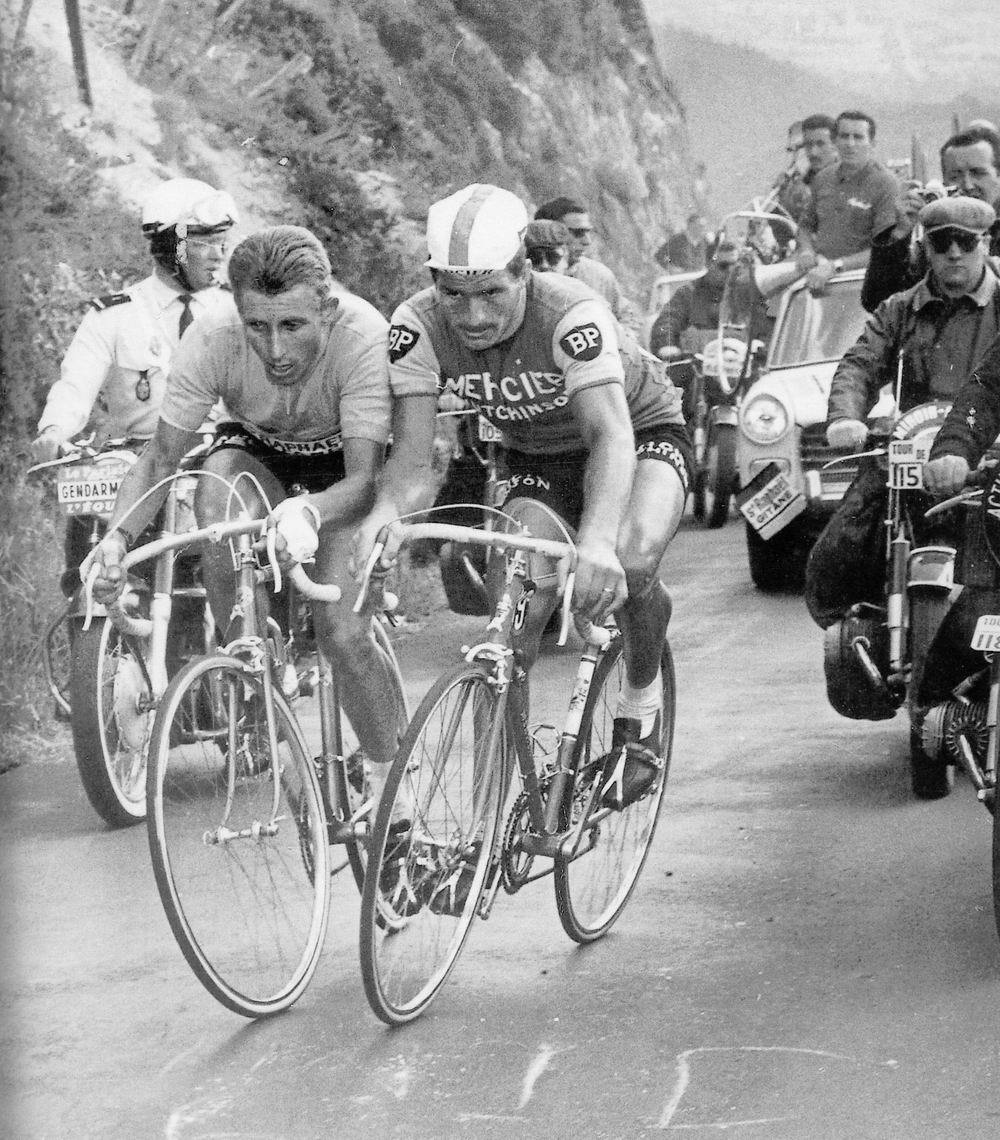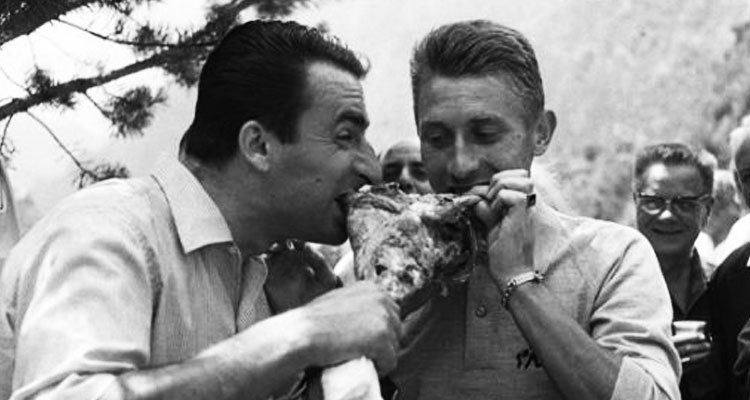The Tour de France enjoys a rest day in Andorra. The first this happened was in 1964 and the race was almost turned upside down, a story of a foretold death, a lamb feast and sangria.
1964?
Lyndon Johnson was US President, Charles de Gaulle French President. Nikita Khrushchev was deposed as Soviet leader. Brazil became a dictatorship. Tokyo hosted the Olympics. Cassius Clay knocked out Sonny Liston. The James Bond film “Goldfinger” is released. The Beatles topped the charts. France was in the middle of a long period of strong economic growth and embracing consumer brands, television and the car and the Tour de France reflected this.

1964 in cycling
Jacques Anquetil wins Paris-Nice. Tom Simpson wins Milan-Sanremo ahead of Raymond Poulidor. Anquetil wins Gent-Wevelgem, taking the bunch sprint. Poulidor wins the Vuelta a España in the spring, it’s a two week race and he wins a time trial in Valladolid just before the final weekend to take the lead and keeps it to Madrid. Anquetil wins the Giro d’Italia for the second time, this was a three week race and he takes the race lead after the Stage 5 time trial in Parma and keeps it to the end in Milan. Miguel Indurain was born.
So far in the Tour
It’s been a thriller. German rider Rüdi Altig takes the yellow jersey when the Tour crosses to Germany, a form of Franco-German reconciliation. It’s been portrayed as a modern tour and the stage to Freiburg is 161km, dubbed as short stage for “le cyclisme moderne” by the TV commentary, designed make the racing more lively as opposed to the “interminable randonnées which made up the large part of old editions”.

There are transfers too, a bus journey between the finish town one day and a different start town the next, seen as modernity again. It’s new and fast, riders complain the Tour is so intense – plus ça change – and the talk on TV is of the high speed of this edition and how close riders still are on the general classification. Poulidor and Anquetil seem inseparable but with the Alps done and the race approaching the final week Georges Groussard (Pelforth Beers) is in yellow going into the Andorra rest day.
The Fortune Teller
Marcel Belline was a fortune teller. Known as the “Prince of Clairvoyants”, he’d called various world events and celebrity deaths, he foresaw Marilyn Monroe’s suicide in 1962 and President Kennedy’s assassination in 1963 and plenty more, presumably he had his share of false alarms but newspapers adored his predictions and it was more than lite entertainment, businessmen and politicians paid beaucoup for private sessions. In his column in France Soir, a newspaper, Belline predicted Anquetil would die on Stage 14.
The Feast
Normally Anquetil was dogmatic about rest days, they were for doing as little as possible. But Anquetil decides to break with his habit of total rest, he went for a ride and drops by a party held by Radio Andorre for an interview. He’s tempted by some méchoui or a whole roasted lamb where he eats plenty, washed down with mucha of of sangria.
Out of Andorra, Bound Toulouse
The rest day over and Anquetil is in trouble as soon as the stage starts. Was it nerves about the prophecy or was yesterday’s méchoui misfiring inside, or a sangria hangover? Maybe it was all three but what was certain is that he’s dropped on the Port d’Envalira as Poulidor and his Mercier team set a fierce pace. It turns out they’d sneakily ridden 40km before the stage as a warm-up and their attack was pre-meditated.
Yellow jersey Groussard is dropped too but Anquetil is further back and feeling dreadful, ready to quit even. Team mate Louis Rostollan is there to encourage him and push him back on his bike, literally as Anquetil would get a time penalty. Anquetil’s directeur Raphaël Géminiani hands up a drink, some accounts say it’s whisky, others champagne, but it’s just the tonic and, amid dense fog on the descent, Anquetil picks up Sels, then Groussard and the chase is on. Poulidor is still ahead in a group of seven as they exit the Pyrenees with Anquetil and Groussard’s group about a minute behind and the pursuit lasts 88km during which Poulidor seems to break a spoke in his wheel but he can’t afford to stop for a spare wheel. Eventually Anquetil makes it back to Poulidor’s group and things ease up. With 24km to go Poulidor gets a new wheel but his mechanic seems too excited and, instead of a helpful push to get going, shoves him to the ground. Anquetil and the others spot this, accelerate and Poulidor is left battling into a headwind and loses over two minutes. Anquetil outrode the prophecy and turned a loss-making start into a substantial gain.
The Next Day
Poulidor is down but not out. He attacked and won the stage by more than two minutes, wiping out the previous day’s time loss.
Onwards
Federico Bahamontes closes in on Groussard and the yellow jersey. Then Groussard implodes in the 42km time trial in the Basque Country, losing almost six minutes and Anquetil takes yellow. He never loses the jersey but cracks on the Puy-de-Dôme as Poulidor closes in to just 14 seconds of the yellow jersey.

Anquetil is tired from the Giro and close to throwing in the towel and the final time trial in Paris is not a conclusion for Anquetil. But he wins his fifth Tour and Poulidor famously finishes second again. Meanwhile Bahamontes and Julio Jiminez keep battling for the mountains jersey, a contest only settled on Stage 21.
Vintage edition
Many will say 1989 was the best edition of the Tour de France. In 1989 many knew they were witnessing a superb race and their reference point, the standard by which Tours were compared was 1964.
Moral of the story
Get your rest day right in Andorra and avoid the newspaper astrology column.


Cracking moral! Thanks.
The contemporary version would be ‘get your rest day right in Andorra and avoid the online crackpots’ 😃
Which definitely sounds good advice still! 🤣
Excellent read, made me laugh (much needed after last night) and interesting also.
On the flip side, Cav may now be more likely to get the sport personality award which he deserves.
I know, it is a bit like cashing in on a teammate bonking, but still, this is life.
Brilliant post. Thank you for the education INRNG!
I think we need to see the ‘shove to the ground’ in hi-definition & slow-motion from multiple angles before laying the blame entirely at the door of the mechanic.
Also the year I outgrew my Phillips (the 0ne with 18″ wheels, fenders, 3-speed internal gear hub with a generator also squeezed inside, and pivot rod brakes) and converted my dad’s single-speed ‘English racer’ from the 30’s one day while he was at work…including a repaint (maroon, with a brush). I was in awe of the fact I had this 30-year old, pre-war bicycle…
Now, almost all my bikes are at least 40 years old, and some over 50, but they do not seem old at all.
Odd, that…
Great stuff! You had me fondly remembering “Sex, Lies and Handlebar Tape”. Anquetil was larger-than-life. No sportsmen like him today that I know of – these daze they’re all monks by comparison 🙁
One thing I wondered about yesterday – do they have any police in Andorra? Were they all on holiday? If there was this lack of crowd control in the Giro d’Italia the fauxtrage would be exploding all over English-language social-media but since it’s LeTour….nothing?
The rest day reaction on riders seems to be one thing that has never been totally understood despite the passage of time?
Whilst drinking wine and chomping on a leg of lamb is probably not the best way to spend a rest day, what is?
It appears to be different strokes for different folks?
We’re almost guaranteed that someone tomorrow will not be feeling good, maybe even one of the riders that are competing for a jersey.
Plus ca change indeed.
Was the 1989 Tour de France really an interesting race day to day or it is famous and only remembered as interesting because of the closest winning margin?
I couldn’t watch it since I was just three months old. 😀
A great edition. The 8 seconds at the end, is just that, the time gap at the end, it’s everything that happened along the way that made it so good. The yellow jersey changed shoulders many times, there was no obvious winner to the end and drama from the very start to the end. Add in the comebacks of both LeMond and Fignon from injury, the 200th anniversary of the French revolution giving the race a theme and identity and more, the more I read, watch, listen about it sounds great.
A great edition for sure. I was 33 and it was the 2nd time I saw Le Grand Boucle live, in-person though I have to confess I didn’t give LeMond a chance-in-hell to gain enough time in the chrono to take the GC from Fignon…same as Pogacar vs Roglic last year.
I was happy to be wrong both times but OTOH I was right about last night’s UEFA final though I predicted 2-1 victory for the Azzurri rather than the crap-shoot finale we saw.
And what about the “Slaying the badger” 1986 edition? I really enjoyed the documentary (not yet the book) but unfortunaltely have no idea about the veracity of it’s outlook about the race; but the intra-team dynamic looks totally captivating tbh.
I read anything I could get my eyes on about the 1986 Tour – it motivated me to see Hinault’s swansong visit to the Coors Classic in preparation for the World’s in CO that same year. Went to the World’s as well.
Two years later I was in France at the Tour and a year later in Italy at Il Giro. Those were the daze!
I look at that period as one of the golden ages of cycling, but perhaps it’s only because I was there – but OTOH a lot of “some of the best of…” happened during this period.
I was fortunate to see some of it live, in-person rather than just on TV or in magazines 🙂
The book is enjoyable too and yes another good edition of the race.
As a kid in the late 80s, I would watch the TdF on ESPN, on the days I wasn’t at a summertime sports camp. I wasn’t into road cycling at all, but found it fascinating. Oh, it was fun when the “all” sports network showed more than the NBA and dramatic personal interest/crime stories.
I didn’t know until quite recently exactly how bad LeMond’s hunting accident was. I didn’t know he was stuck deep in the woods, was very lucky to be evacuated just in time, and really came close to not making it at all. I knew about the shooting, the birdshot, the long recovery to win again…but I really never knew the details of him almost not making it to the hospital. What a crazy incident!
It was and he was written off. In fact his team wasn’t even invited to the 1989 Tour de France but as luck happened the Italian Ariostea team decided to turn down their invitation so in late May LeMond’s ADR team were asked if they could replace Ariostea; but even at this point he was adrift in the Giro and the final time trial and resurgence had yet to happen.
Great story. I particularly enjoyed the irony of this bit: *”It’s been portrayed as a modern tour, the stage to /presumably Freiburg?/ 161km, dubbed as short stage for “le cyclisme moderne” by the TV commentary, designed make the racing more lively as opposed to the “interminable randonnées which made up the large part of old editions”.”* We’re still the same.
That said, I feel weirdly “nostalgic” reading it – it’s a picture of a completely different, distant world. I was born almost 20 years after the race and while I enjoy the culture and the spirit of the 60s (the race coincided with modern masterpieces such as Il deserto rosso and Otto e mezzo, to further explore the period context such wonderfully outlined by Inrng, as well as with the Gulf of Tonkin incident etc.) and while I fondly remember the races won by certain mr Indurain mentioned in the text (the short TV reports avidly anticipated by a small child each and every day) I feel totally disconnected to this era of Coppi and Anquetil and Merckx even…
Thank you for posts such as this, mr Inrng. I enjoy those “other” posts probably the most.
Oh, and Dr. Strangelove, or… – one of Kubrick masterpieces… 🙂
Somethings never seem to change like the Tour visiting Pau.
Maybe it is my imagination or a misreading of the map but this route seems much longer than the modern ones. The route this year is similar but no visit to Flanders (or Germany!) and plenty of gaps between stages. If true I am sure it would occasion many comments along the lines of how the riders were tougher in days gone by.
It is a shame that the riders cant really relax on “rest days”, the days of parties with the locals are long gone, not just in cycling but in most professional sports.
According to wiki, it was considerably longer – about 4500 km.
If the overnight stage transition via bus was a novelty, i guess this was the beginning of “la boucle” not really being a boucle any more. Where the riders ended one stage, they near enough started the next one. Almost as if the bicycle was a means of transportation rather than entertainment!
I still can’t believe the tour was almost literally a circuit round the edges of l’hexagone (without gears or much of a support structure!). How things have changed in the 100+ years of the sport.
Looking at the map above, I was pondering that point. I think to a much larger degree, with quieter roads, the race chose its stage towns and rode a largely direct route between them. Whereas today, you might take 200km to move between two towns only 50km apart, but on roads that have some notable feature to promote the action.
Another common feature of the era was mountain stages with the final mountain well removed from the finish – exemplified by the stage from Andorra to Toulouse. Not much option to have a final 15km climb in the final if you want to finish in Toulouse, but these days you wouldn’t generally plan a route like that – the reverse, maybe.
Perhaps the stage to Toulouse was planned (at least partly) to enable the next stage to Luchon across Aspet and Mente?
Also there was just one rest day and if I read the map correctly, the only bus transfer took place between Pau and Peyrehorade, just 80 flat kms…
And two of the time trials had road stages in the morning. No need to warm up on the turbo trainer.
Interesting start and finish dates.
Starting on a Monday (!), the 22nd June – earlier than this year’s Tour, which itself is a week earlier due to the Olympics (and note that the 64 Olympics didn’t start until October!)
Finish is on Bastille Day (a Tuesday!) – was this usual?
Very interesting indeed. Anquetil gives the impression of being supremely blessed (I’m sure if he was around now we’d know he had a Vo2 max of 99 or something) and able to almost toy with his competitors. Almost like ‘well, you can lie in bed and drink water if you want. But I’m going to a party to get pissed, and I’ll still beat you tomorrow’. If you wanted to add a ‘great races’ tab to this website I certainly wouldn’t complain.
… and the 1964 Olympics were in Tokyo. (cue “Tokyo Melody” :))
On great Tours: I’ve often pondered the degree to which the dominant media of the era colours our view of greatness. Today we have live pictures end to end, and what makes a great race is rather different from the days of newsreels and the written word.
As an example: one of the great exploits of any post-war Tour de France was Hugo Koblet winning the stage from Brive – Agen in 1951. But had you watched it live: would a 140km solo breakaway have been that riveting? You get the sense Carlton Kirby et al would have spent a lot of time describing churches and giving out recipes. It became great in part because through retrospect (Koblet went on to win, and that was therefore a precursor to victory rather than just a random stage win); partly because a journalist can make drama out of the longeurs of a solo break in a way that film can’t.
The Anquetil – Poulidor rivalry is, by contrast, encapsulated in a perfectly timed single still photo, which tells you more than a film of the event could ever do.
In the modern era: the chaotic openings of several stages on this tour, with the attacking lasting for an hour or more before the break forms is made for TV: gripping to watch, but impossible to convey properly in a written report.
A favourite Tour for me is 1978: but in part that is coloured by a brilliantly written book by Robin Magowan. (Oh, and Hinault won, which helps …) That, and Geoffrey Nicholson’s “Great Bike Race” about the 1976 Tour make those races come alive.
Sublime.
just a minor correction, it’s Rudi, not Rüdi Altig 😉